Everything you need to know about heating a cottage from A to Z
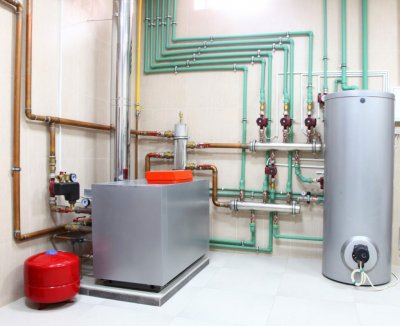
For each private cottage, as a rule, its own autonomous heating.
It is designed taking into account the number and location of rooms, wall material and other parameters.
A well-made project will allow you to achieve the desired temperature in different zones and significantly save money during use. Paying competent designers will be an excellent investment.
Content
What is cottage heating?
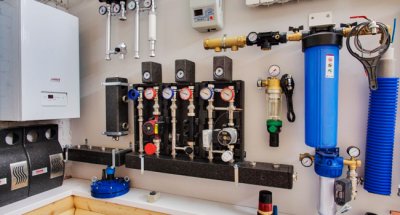
The most commonly used option in Russia is a heating system that uses liquid heat carrier, including boiler, piping and radiators.
This heating option is justified for year-round use of the cottage.
Types of boilers
Boilers are differentiated by the following criteria:
- By type of fuel;
- By number of contours;
- By power;
- By installation method.
Fuel used
The type of fuel is often selected based on its availability in a particular area:
- gas;
- solid fuel;
- liquid fuel.
There are also boilers that run on electricity.
It makes sense to calculate the cost of heating for each type of fuel in the region.
Gas boilers
If gas is supplied to the site, then gas boilers are considered first and foremost as the most automated and economical.

Photo 1. Wall-mounted gas boiler Gaz 6000 W, double-circuit, efficiency 93%, manufacturer - "Bosch".
If the area is not gasified, it is possible to use gas holder (gas storage facilities) or cylindersBut these options are much more expensive.
Solid fuel boilers
Work on firewood, coal, pellets. This heating option is also considered inexpensive. But it has a number of disadvantages:
- necessity periodic bookmark fuel;
- dust and dirt, especially when using coal;
- the need to arrange special premises for storing fuel.
To simplify the use of solid fuel, consider pyrolysis wood-fired boilers that operate on one load much longer (according to some sources, up to 24 hours). And also pellet units: when installing a pellet bunker, the loading time is quite significant and depends only on depending on the size of the bunker.
Important! Fuel is burned in pyrolysis boilers no more than 20% humidity.
Liquid fuel boilers
The following fuels are used:
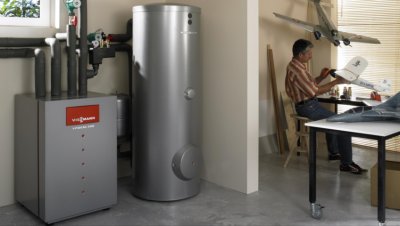
- diesel;
- waste oil;
- fuel oil;
- oil.
In this case, a fuel tank is required. The disadvantages of this type of fuel include:
- presence of odor;
- noise;
- need for a separate room for the boiler.
Electric boilers
In conditions when in Russia only a total of several kilowatts of electricity, the use of this type of boilers is very limited. It is possible to consider only not very powerful models. The costs of such heating will be higher than, for example, when using a gas boiler with main gas.
The advantages of this type include the possibility of significant automation and no need for fuel.
It is possible to optimize costs using two-phase electricity metering system. It makes sense to install a heat accumulator, the water in which is heated at night and then used during the day, when the tariff is higher.
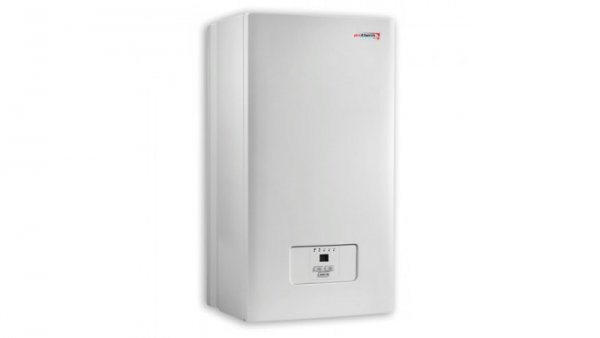
Photo 2. Wall-mounted electric boiler Skat 12K, voltage 220 W, manufacturer - "Protherm".
Number of heating circuits
The market offers single-circuit and dual-circuit boilers. The first are more expensive and powerful, and in the basic version they are designed only for heating. If it is also necessary to heat hot water, they require the installation of a separate boilersAt the same time, they cope well with both heating and heating large volumes of water.
Boilers with two contours provide both heating and water heating at the same time. They have a built-in heat exchanger, and water heating is produced using their own boiler or a flow-through method. Their prices are more affordable, but in general they are characterized by lower power and a moderate volume of heated water (no more than 15-20 liters per minute). Suitable for small cottages without a significant number of residents.
Reference! Most modern boiler models can operate in summer. for heating water only with the heating circuit turned off.
Boiler power
All boilers differ in power. As a basic calculation rule, the power of the device is determined as 1 kW per 10 sq. m. of building.
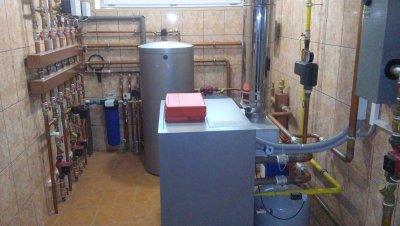
That is, for the home in 100 sq. m. a boiler with a capacity of 10 kW. It is worth laying down some order 15% stock. And also take into account that the given formula is calculated for houses with good insulation.
A specialist will make a more accurate calculation., taking into account additional parameters (wall thickness and material, number and quality of windows, number of floors, climate zone).
Installation methods
The boiler's power also affects its location in the house. Devices low power can be mounted on the wall in the kitchen (except for double-circuit ones), and for high power It is necessary to equip a separate room that meets fire safety requirements.
Boilers are:
- wall-mounted;
- floor-standing.
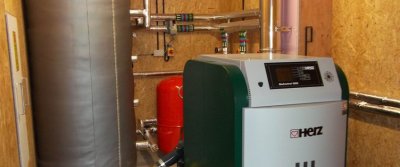
Wall-mounted boilers can be gas or electric. These are usually light, lower-power devices with a smaller set of accompanying equipment.
Floor installation does not limit the weight of the boiler, it often uses cast iron components, such a device is supplemented with a pump and an expansion tank. The productivity of such boilers is unlimited.
Installation of boilers
Each type of boiler has its own connection scheme and a number of requirements for the room and ventilation, as well as a set additional equipment (including for storage and supply of fuel).
Installation
Installation of heating boilers strictly standardized by rules. Gas boilers are installed only in non-residential premises, except for bathrooms. Depending on the boiler capacity, there are restrictions on the floor of installation and the area of the boiler room. There are requirements for wall materials, the presence and size of a window, the width of the door, etc.
Important! There are many requirements, and failure to comply with them threatens not only fines, but also risk to life.
The installation of a gas boiler is preceded by a conclusion agreements with a gas supply organization, and creation of a gasification project and installation of gas equipment.
Scheme

The basic heating scheme using a gas boiler includes:
- boiler with gas and water supply;
- chimney;
- expansion tank;
- circulation pump;
- boiler;
- security group;
- pipes;
- radiators.
The least complicated are electric boilers, which do not require fuel supply and storage and the presence of a chimney. Other parts of such a system are basically similar to the one described.
All types of boilers, except for traditional ones that run on solid fuel, are also connected to electricity.
Divorce
There are two main ones heating layout diagrams based on the method of circulation of liquid coolant:
- With natural movement;
- With forced movement.
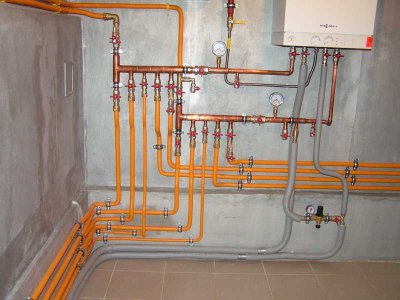
The first option is used in small circuits. up to 30 m on one floor. For larger buildings, the second one with a circulation pump is suitable.
According to the type of pipeline layout, the following are distinguished:
- vertical and horizontal schemes;
- one-pipe and two-pipe.
Two-pipe systems require longer pipe lengths, but allow individual radiators to be turned off.
The horizontal system allows you to turn off entire floors. The choice of the optimal layout scheme makes it possible to solve the problems of specific consumers.
Radiator heating systems
This is the most commonly used option for heating buildings in Russia. From the boiler, the liquid heat carrier is delivered through pipes to the radiators (batteries), and with their help the rooms are heated.
Types of radiators
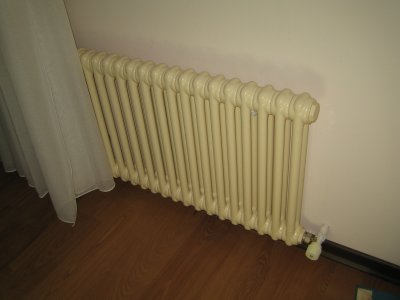
By form:
- sectional;
- tubular;
- lamellar.
Based on the material:
- steel;
- cast iron;
- aluminum;
- bimetallic.
Calculation of the number of batteries
It is performed when ordering a project. If it is necessary to calculate the number of radiators independently, use two basic approaches:
- by area premises;
- by volume premises.
The first one is suitable for rooms with standard ceiling height 2.7 m. In this case it is necessary 100 watts of power radiator per 1 sq. m of area. The data for each device is indicated in its technical specifications.
For rooms with non-standard heights, they calculate 41 W of power per 1 cubic meter of volume in a panel building, 34 W - in a brick house.
There are also other characteristics that are taken into account when designing heating, such as the type of windows. For detailed calculations, online calculators, but it is better to consult a specialist.
Safe operation of boiler equipment
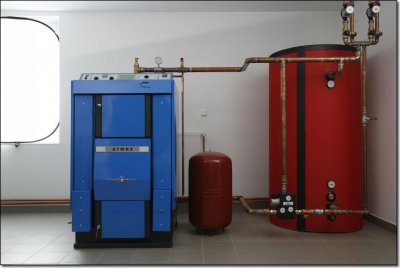
Operation of all types of boilers is safest within the service life specified by the manufacturer, which it is advisable not to exceed.
Each type of boiler has its own rules for safe operation.
For gas boilers are:
- fulfillment of all boiler installation rules (requirements for the boiler room and ventilation) and their further compliance;
- installation gas analyzer;
- regular check gas equipment according to the instructions;
- absence unauthorized reinstallation and repair of gas equipment and others.
For solid fuel boilers that are dangerous due to carbon monoxide emissions into the premises, the following is required:
- proper arrangement chimney;
- regular cleaning chimney;
- installation of a device that informs about increased carbon monoxide content in the air;
- measures to prevent fires from fuel falling out of the firebox;
- device and maintenance high-quality thermal insulation chimney.

Safe to use electric boilers assumes:
- installation and repair with the help of Electrics with the appropriate level of clearance;
- availability and functionality grounding;
- availability safety switch and residual current devices.
For each specific boiler there is an instruction manual containing the rules for safe operation.
Useful video
Watch the video to learn how to install a gas boiler.
Heating installation by specialists - efficient and safe
Heating equipment poses a hazard if not installed and operated correctly. And incorrectly performed calculations lead to poor heating of the building and excessive costs. Therefore attracting professionals to the design and installation of the heating system completely justified.







Comments